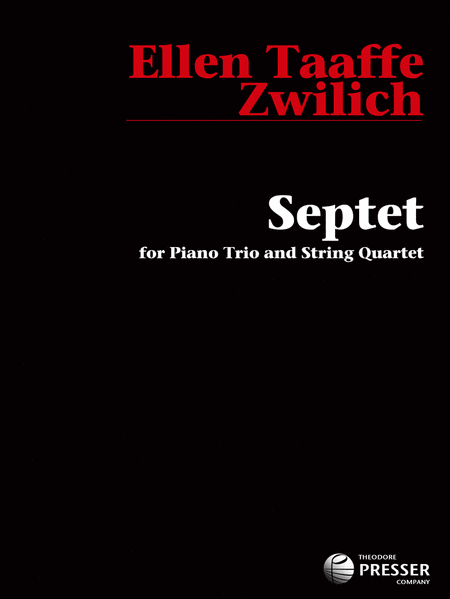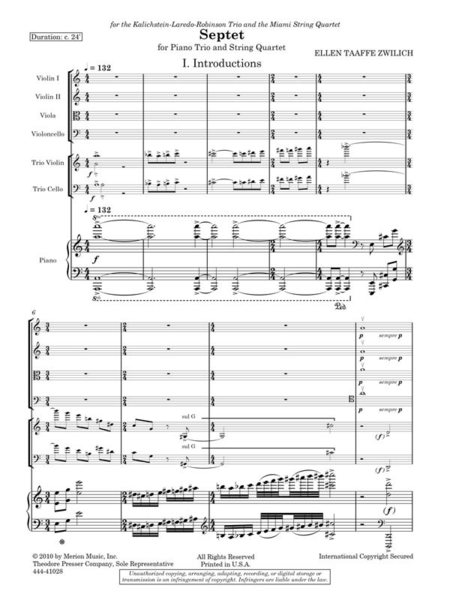Septet
For Piano Trio and String Quartet
Details
Description
SKU: PR.444410280
For Piano Trio and String Quartet. Composed by Ellen Taaffe Zwilich. Premiered: 92nd Street Y, New York, NY. Score. With Standard notation. 60 pages. Duration 24:00. Theodore Presser Company #444-41028. Published by Theodore Presser Company (PR.444410280).ISBN 9781598062557. UPC: 680160587827.
Ellen Taaffe Zwilich’s Septet is the first major work written for this combination of instruments, and the pioneering process was greatly enjoyed by the composer: “While the instrumentation of the Septet provides an almost orchestral palette, and it was interesting to explore that, I love the idea of seven artist-performers, each of whom can be a stunning virtuoso one moment and a thoughtful partner the next, and I relish the electricity that results from those shifting roles.” Septet was written for the Kalichstein-Laredo-Robinson Trio and the Miami String Quartet, to whom it is dedicated. String parts available on rental. For advanced ensembles. Duration: 24’.
Writing music is a labor of love for me. My greatest joy is writing for performers whom I can be sure will not only deliver the notes accurately, but will project the meaning behind the notes. To have performers in the wings who will bring their own imagination and deep understanding to a performance is an inspiration to me. So I approached the writing of my Septet for the Kalichstein-Laredo-Robinson Trio and the Miami String Quartet with great anticipation and pleasure.The fact that there is no model for such a Septet made the pre-composition process a most enjoyable exploration. I liked the idea of having two strong ensemble personalities in the mix, and I thought that there must be some sort of challenging interchange at the outset. The first movement, “Introductions,” (note the plural) starts with the piano trio throwing down the gauntlet and the string quartet entering quietly, but gradually (almost one by one) joining with the trio to make a true septet with multi-faceted relations. The second movement, “Quasi una Passacaglia,” is based on a repeated phrase pattern. Part of the formal design is a contrast between “Baroque” style performance and modern, more romantic ways of playing. “Games,” the third movement, involves much playful interplay and the fourth movement, “Au revoir,” offers both reminiscence and farewell – not “good-bye,” but “until we meet again.”Throughout the piece, two of my persistent fascinations are explored: firstly, my interest in designing initial material that can evolve into large-scale form, and secondly, the pleasure I take in chamber music. While the instrumentation of the Septet provides an almost orchestral palette and it was interesting to explore that, I love the idea of 7 artist-performers, each of whom can be a stunning virtuoso one moment and a thoughtful partner the next, and I relish the electricity that results form those shifting roles.


 Share
Share